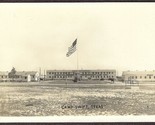Camp Swift, Bastrop, TX RPPC 1940s - Official Buildings Real Photo Postcard #1
Ships from
United States

Don't miss out on this item!
There is only 1 left in stock.
Shipping options
Estimated to arrive by Tue, Jun 3rd.
Details
This estimate is based on:
- The seller's handling time
- unspecified transit time to GB
Actual delivery times may vary.
Have shipping questions? Contact the seller
Calculated by USPS in GB.
Ships from
United States

Return policy
Full refund available within 30 days
Payment options
PayPal accepted
PayPal Credit accepted
Venmo accepted
PayPal, MasterCard, Visa, Discover, and American Express accepted
Maestro accepted
Amazon Pay accepted
Nuvei accepted
Shipping options
Estimated to arrive by Tue, Jun 3rd.
Details
This estimate is based on:
- The seller's handling time
- unspecified transit time to GB
Actual delivery times may vary.
Have shipping questions? Contact the seller
Calculated by USPS in GB.
Ships from
United States

Return policy
Full refund available within 30 days
Payment options
PayPal accepted
PayPal Credit accepted
Venmo accepted
PayPal, MasterCard, Visa, Discover, and American Express accepted
Maestro accepted
Amazon Pay accepted
Nuvei accepted
Item traits
| Category: |
Topographical Postcards
|
| Quantity Available: |
Only one in stock, order soon
|
| Condition: |
Unspecified by seller, may be new.
|
Antique Real Photo Postcard, circa 1940s. Identified as the Camp Swift Official Buildings. Published by L.L. Cook Co. Card #6. Divided back, EKC stampbox, unused. Condition: This is an original photo postcard, not a copy or reproduction. It is in excellent condition. Comments: Construction began for Camp Swift in 1941. At one point it housed 90,000 troops. In 1942, the camp opened its doors with 2,750 buildings and accommodations for only 44,000 troops. It would become a major combat infantry training camp for World War II troops. It was named after General Eben Swift. He had led troops in World War I as a commander, and later he became a recognized author of several military books. Training activities at Camp Swift included tank maneuvers, weapons firing, personnel and cargo air drops, small arms firing, combat engineering skills, infantry skills, helicopter operations and other types of training environments for the field. The Army helped to construct all of the buildings at Camp Swift including warehouses, training facilities, recreational facilities, artillery ranges, barracks, gas stations, storage tanks and more. Eventually it would also house over 3,500 German prisoners of war.
